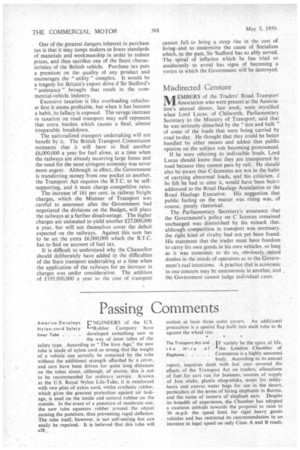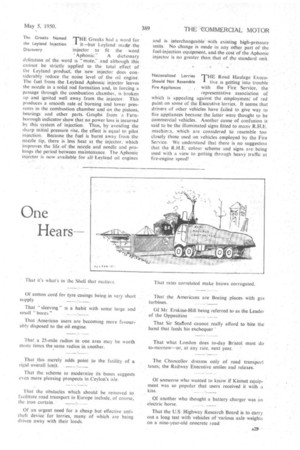Passing Comments
Page 30

Page 31

If you've noticed an error in this article please click here to report it so we can fix it.
America Develops NCIINEERS of the U.S.
Nylon-cord Safety "Rubber Company have Inner Tube . . developed something new in
the way of inner tubes of the Safety type. According to "The Iron Age," the new tube is made of nylon cord so strong that the weight of a vehicle can actually be sustained by the tube without the additional strength afforded by a cover, and cars have been driven for quite long -distances on the tubes alone, although, of course, this is not to be recommended for ordinary service. lc: flown as the U.S. Royal Nylon I.ife-Tube, it is reinforced with two plies of nylon cord, whilst synthetic rubber, which gives the greatest protection against air leakage, is used on the inside arid natural rubber on the outside. In the event of a puncture of moderate size, the new tube squeezes rubber around. the object causing .the puncture, thus preventing rapid deflation. The tube itself, however,.. is not self-sealing but can easily be repaired. , It is believed that this tube will ra8
outlast at least three outer covers. An additional precaution is a special flap built into each tube to fit against the wheel rim.
The Transport Act and IF variety be the spice of life. the Hire of 'the London Chamber of
Elephants Commerce is a highly seasoned body. According to its annual report, inquiries dealt with last year covered the effects of the Transport Act on traders, allocations of fuel for cars run for business, sources of supply of Joss sticks, plastic chop-sticks, noses for teddybears and canvas water bags for use in the desert, particulars of the terms of hiring elephants in Burma, and the name of tanners of elephant ears. Despite its breadth of experience, the Chamber has adopted a cautious attitude towards the proposal to raise to 30 m.p.h. the speed limit for rigid heavy goods vehicles and has restricted its recommendation to an increase in legal speed on only Class A and B roads.
The Greeks Named THE Greeks had a word for the Leyland Thjettion it—butLeyland made.the Discovery injector to fit the word • 'Aphonic.A dictionary definition of the word is "intite,.... and although this cannot be strictly applied to the total effect of the Leyland product, the new injector does considerablY "reduce the noise level of the oil engine. The fuel from the Leyland Aphonic injector leaves the nozzle in a solid rod formation and, in forcing a passage through the combustion chamber, is broken up and ignited well away from the injector. This produces a smooth rate.of burning and lower pressures in the combustion chamber. and on the pistons, bearings and other parts. Graphs from a Farnborough indicator show that no power loss is incurred by this system of injection. Thus, by avoiding the sharp initial pressure rise, the effect is equal to pilot injection. Because the fuel is burnt away from the nozzle tip, there is less heat at the injector, which improves the life of the .nozzle and needle and prolongs the period between maintenance_ The Aphonic injector is now available for all Leyland oil engines
and is interchangeable-With existing high-pressure units. No change is made in any other part of the fuel-injection equipment: and.the cost of the Aphonic injector is no greater than that of the standard unit.
Nationalized Lorries THE Road Haulage Execu Should Not Resemble I five is getting'into trouble Fire Appliances with the Fire Service, the
representative association of which is appealing against the ernploymen: of red paint on some of the Executive lorries. It seems that drivers of other vehicles have failed to give way to lire appliances because the latter were thought to be commercial vehicles. Another cause of confusion is said to be the illuminated signs fitted to many R.H.E. machincs, which are considered to resemble too closely those used on vehicles employed by the Fire Service. We understand that there is no suggestion that the R.H.E.colour scheme and signs are; being used with a view to getting through heavy traffic at fire-engine speed!
























































































